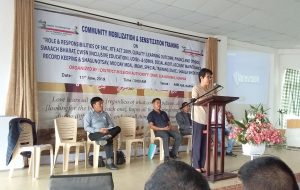Nagaland
‘SMC’s failure to play its role causing poor performance among schools’

Our Correspondent
Kohima, June 11 (EMN): A community mobilisation and sensitisation training on education-related acts, schemes, roles and responsibilities was conducted at AMK Building, in Kohima on June 11.
The two-day programme has been organised by the District Mission Authority, Sarva Shiksha Abhiyan, Kohima.
The main objective of the training is to share practical difficulties faced at the grassroots level when implementing educational programmes. According to the State Mission Director of Samagra Shiksha, Nagaland, Kevileno Angami, it also envisages learning from one another’s success and failure stories.
She spoke about the State Government’s Communitisation of Public Services Act, 2002. Under the Act, she said, setting up of education committee is mandatory in each village, and every ward in every town.
The director was of the opinion that the village education chairman (now School Management Committee) has not been able to play his role, which in turn has let down the educational centres in the villages. Under the Right to Education Act, 2009, SMC was set up, which includes teachers, parents, village councils, she added.
She encouraged the participants to invest in their children in every possible way. The community should come forward to help the children, even without waiting for the government’s support, she added.
Assistant professor (Reader), SCERT Nagaland, Thungchibemo Lotha, spoke on the topic ‘Special training and learning outcome.’
“Earlier, special training was known for alternative schooling. But, with the RTE Act, 2009, ‘special training’ was initiated in 2012, to revitalise elementary education,” he said.
One of the main objectives of the special training is to bring the out of schoolchildren (OoSC) into the mainstream, and retain them by enrolling in the proper schools. He pointed out the dropout rate is high at all levels, because of ‘low detention policy’.
According to a 2016-17 statistical report for Nagaland, 20% of the dropout students are from the elementary level. Meanwhile, the dropout percentage at secondary level of schooling is 31.28%.
Some of the reasons leading to the increase in dropouts could be attributed to personal reasons like sickness, migration, absenteeism, repeated failure and lack of study habit, he said while asserting that it is the duty of the SMC to console them and get them back to school.
‘Home factor and school factors including teacher’s absence, irregularities, discouraging school environment like lack of infrastructure, and wrong system of examination were among other reasons for the high dropout rate,’ the professor added.
‘The guiding principle of the special training education programme is aimed at adopting the right kind of strategy to fulfil the educational needs of the children. Individual strategy should be given to the children according to their needs and fresh habitation-wise assessment must be carried out,’ he said.
A specially designed and appropriate learning material has been approved by the academic authority for the OoSCs, he informed. In Nagaland, the course spans three months.
Another resource person, P Shilu Ao, the Joint Director of SCERT said: “Good education is the only answer to our backwardness.”
He also informed that a ‘Naga Heritage’ textbook has been introduced by the SCERT this year in order to preserve the rich culture of the Nagas.

